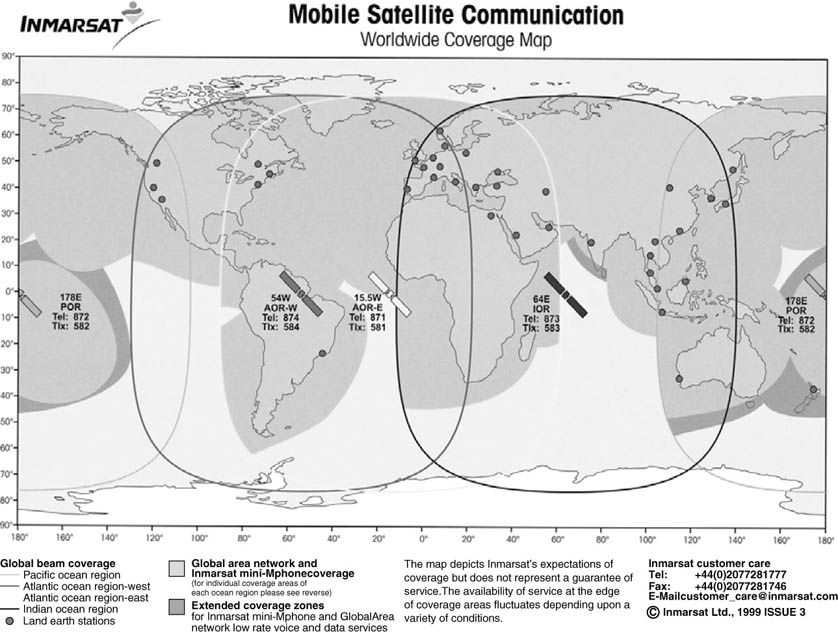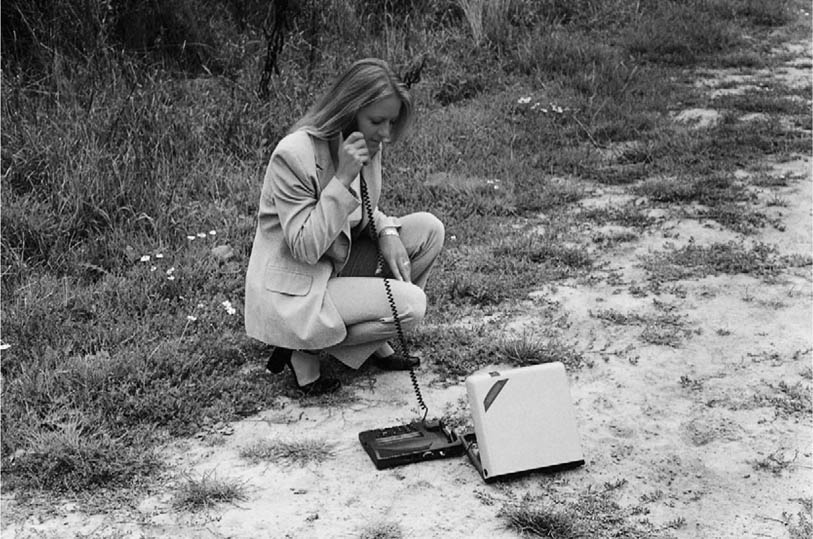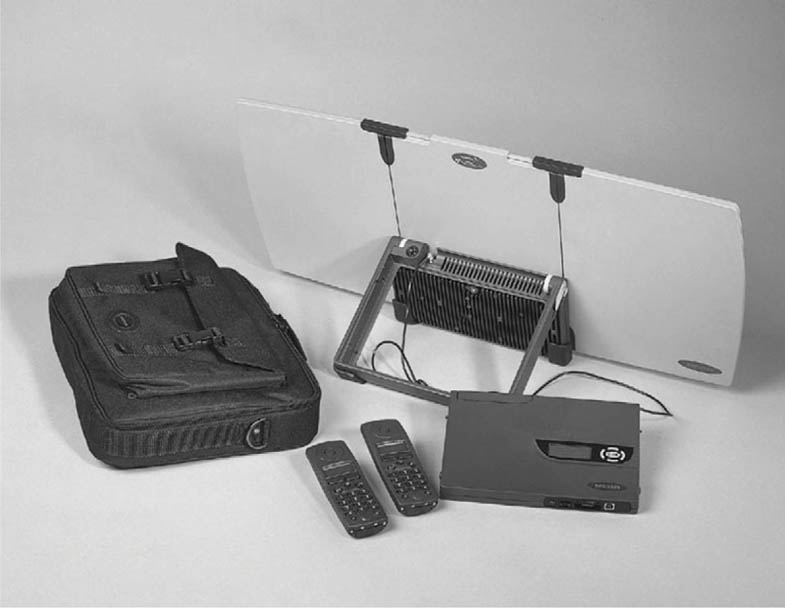Inmarsat and the use of videophones
In the last year or so, everyone has seen widespread use of the ‘Videophone’ – the latest newsgathering tool that has become the ubiquitous tool for front-line newsgathering. No discussion of current SNG techniques can overlook the videophone phenomenon.
We will look at how the videophone works in a minute, but first, we need to look at the means of transmission that the videophone use – the Inmarsat satellite telephone system. The Inmarsat system is also used to send high quality pictures – albeit not in real time – using a system called Store and Forward.
Inmarsat system
Originally designed for maritime communication, the Inmarsat system has now expanded to other market sectors, including newsgathering. In recent years, the Inmarsat system has become a vital tool for global newsgathering, used not only for person-to-person voice communication for ‘keeping-in-touch’, but for transmitting back various types of media – high-quality still pictures, studio-quality audio for radio reports, and even TV pictures ‘live’ using ruggedized videophone units, or non-real time transfer using Store and Forward video units.
Using Inmarsat satphones, pictures and sound can be sent from almost anywhere on the globe. This versatility, combined with increasingly compact equipment, has enabled Inmarsat to become a significant force in news-gathering.
The Inmarsat system consists of four geostationary satellites operating in L-band (see page 85) that cover most of the Earth’s surface and have a range of services with different capabilities. There is a satellite above each of the ocean regions – Indian, Pacific and Atlantic (there are actually two over the Atlantic). Between them, the main (global) beams of the satellites provide overlapping coverage of the whole surface of the Earth apart from the poles (see map opposite).
A call from an Inmarsat mobile terminal goes directly to the satellite overhead, which routes it back down to a ‘gateway’ station on the ground called a land earth station (LES). From there, the call is passed into the public phone network.
All services offer the same common core feature – instant and on-demand dial-up access limited only by satellite capacity and coverage using portable mobile terminals. Those used on land (as opposed to maritime or aero units) are referred to as land mobile earth stations (LMES). Typically the LMES offer two types of service – voice and data. Voice speaks for itself(!), and data generally comes in two flavours – low speed 9.6 kbps typically for use with a laptop, and high speed data (HSD) which runs at 64 kbps – the same speed as ISDN lines in offices and homes.
Because of our interest in newsgathering, we will use the term for the LMES used by all newsgatherers – the satellite telephone or more often referred to as the ‘satphone’.
Inmarsat coverage map (© Inmarsat Ltd)

The various types of satphone
There is a whole family of satphones of various types for various applications. But we are going to focus only on two – Inmarsat Mini-M and Inmarsat GAN – as these are the ones used widely for newsgathering. Both of these types of phones are compact, light (and easy to carry), and simple to operate.
Inmarsat Mini-M
The Mini-M satphone was introduced in 1996 and is approximately the size of a notebook computer. The satphone has the option of using a SIM card so that service is bought and access-controlled in the same way as GSM. The available services are voice, data and fax, but with no HSD service. From the point of view of keeping in touch in hazardous areas, the Mini-M satphone has a distinct advantage for newsgatherers. It is available in vehicle-mounted versions from a few manufacturers, and this allows a small and relatively discreet auto-tracking antenna to be easily fitted to the roof of a car, with the handset and control unit inside the car. This has a great advantage in that the satphone is permanently rigged, and calls can therefore be made or received on the move, rather than having to stop and get out of a vehicle to set the satphone up before use.
Inmarsat Mini-M satphone (© Nera Satellite Services Ltd)

Inmarsat GAN
Inmarsat GAN is the most common type of satphone used by newsgatherers for not only keeping in touch but also for sending back reports. Sometimes referred to as Inmarsat ‘M4’ satphones (this was the project name during the GAN system development), the terminals are the size of a laptop computer, weighing under 4 kg (10 lb), and offer voice, fax, file transfer and HSD at up to 64 kbps. The coverage of Inmarsat GAN is, like Mini-M, mostly limited to continental land masses only. The Inmarsat GAN satphone is shown in the figure opposite.
Although technically it is possible to use Inmarsat satphones in virtually any country in the world, some countries either do not permit its use, or if they do, make it prohibitively expensive to do so. Inmarsat is encouraging those countries to remove or reduce the regulatory barriers that restrict or prevent the use of its equipment within their borders.
Some countries prohibit any use of mobile satellite communications equipment, while others permit it only in particular circumstances, such as for disaster relief or emergencies, or in limited geographical areas.
Anyone considering taking an Inmarsat satphone to another country is advised to contact the authorities in the country they plan to visit, to get up-to-date information on any conditions attached to use of the terminal in the visited country. Failure to secure the appropriate approvals is likely at the very least to result in confiscation of the equipment at the point of entry to the country, or even in some countries, arrest on the grounds of suspected espionage.
Inmarsat GAN satphone (© Nera Satcom AS)

The dramatic impact on newsgathering of using Inmarsat GAN satphones is the ability to transmit news pictures from places where:
• there is no infrastructure for TV transmissions
• local politics or the overall logistics prevents the deployment of conventional SNG flyaways
• the news story has not developed to the point where it is considered cost-effective to deploy an SNG flyaway.
The GAN phone is designed to work with Integrated Services Digital Network (ISDN) services, used for public dial-up data service in many countries around the world.
As the ISDN numbering system follows the same pattern as the normal telephone system, dialling is carried out in exactly the same manner as making a normal telephone call. The subscriber number is used with the same area codes as the telephone network and international codes are also the same and used in the same way as for the telephone network.
Calls to an Inmarsat GAN satphone are made in exactly the same manner as a normal international call. Dial the home country’s international access code, followed by the Ocean Region code and finally the number of the satphone. The Ocean Region Codes are:
| Atlantic Ocean Region – East | 871 | |
| Pacific Ocean Region | 872 | |
| Indian Ocean Region | 873 | |
| Atlantic Ocean Region – West | 874 | |
For dialling from a satphone to a landline, the following parameters on the Inmarsat GAN satphone need to be set prior to dialling the destination ISDN number:
• the LES (the earth station gateway) to be used
• set satphone in HSD mode
The procedures for checking and setting these parameters are given in the satphone manufacturers operating guide.
